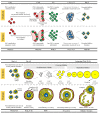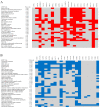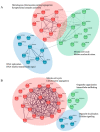Female Germ Cell Development in Chickens and Humans: The Chicken Oocyte Enriched Genes Convergent and Divergent with the Human Oocyte
- PMID: 36232712
- PMCID: PMC9570461
- DOI: 10.3390/ijms231911412
Female Germ Cell Development in Chickens and Humans: The Chicken Oocyte Enriched Genes Convergent and Divergent with the Human Oocyte
Abstract
The development of germ cells and other physiological events in the differentiated ovary of humans are highly conserved with several mammalian species, except for the differences in timing. However, comparative knowledge on this topic is very scarce with respect to humans and lower vertebrates, such as chickens. In chickens, female germ cells enter into meiosis around embryonic day (E) 15.5 and are arrested in meiotic prophase I as primary oocytes. The oocytes arrested in meiosis I are accumulated in germ-cell cysts; shortly after hatching, they are enclosed by flattened granulosa cells in order to form primordial follicles. In humans, the process of meiotic recombination in female germ cells begins in the 10-11th week of gestation, and primordial follicles are formed at around week 20. In this review, we comprehensively elucidate both the conservation and the species-specific differences between chickens and humans with respect to germ cell, oocyte, and follicle development. Importantly, we provide functional insights into a set of chicken oocyte enriched genes (from E16 to 1 week post-hatch) that show convergent and divergent expression patterns with respect to the human oocyte (from week 11 to 26).
Keywords: chicken; gene conservation; gene expression; germ cell; human; oocyte.
Conflict of interest statement
The authors declare no conflict of interest.
Figures



Similar articles
-
Arrest at the diplotene stage of meiotic prophase I is delayed by progesterone but is not required for primordial follicle formation in mice.Reprod Biol Endocrinol. 2016 Dec 5;14(1):82. doi: 10.1186/s12958-016-0218-1. Reprod Biol Endocrinol. 2016. PMID: 27919266 Free PMC article.
-
The art of oocyte meiotic arrest regulation.Reprod Biol Endocrinol. 2019 Jan 5;17(1):8. doi: 10.1186/s12958-018-0445-8. Reprod Biol Endocrinol. 2019. PMID: 30611263 Free PMC article. Review.
-
Intact fetal ovarian cord formation promotes mouse oocyte survival and development.BMC Dev Biol. 2010 Jan 8;10:2. doi: 10.1186/1471-213X-10-2. BMC Dev Biol. 2010. PMID: 20064216 Free PMC article.
-
[Reconsidering the roles of female germ cells in ovarian development and folliculogenesis].Biol Aujourdhui. 2011;205(4):223-33. doi: 10.1051/jbio/2011022. Epub 2012 Jan 19. Biol Aujourdhui. 2011. PMID: 22251857 Review. French.
-
From primordial germ cell to primordial follicle: mammalian female germ cell development.Genesis. 2006 Dec;44(12):622-32. doi: 10.1002/dvg.20258. Genesis. 2006. PMID: 17146778 Review.
Cited by
-
Identification of potential angiogenic biomarkers in human follicular fluid for predicting oocyte maturity.Front Endocrinol (Lausanne). 2023 Aug 10;14:1173079. doi: 10.3389/fendo.2023.1173079. eCollection 2023. Front Endocrinol (Lausanne). 2023. PMID: 37635970 Free PMC article.
-
Vitamins, Coenzyme Q10, and Antioxidant Strategies to Improve Oocyte Quality in Women with Gynecological Cancers: A Comprehensive Review.Antioxidants (Basel). 2024 Dec 19;13(12):1567. doi: 10.3390/antiox13121567. Antioxidants (Basel). 2024. PMID: 39765895 Free PMC article. Review.
-
Transcriptome and chromatin accessibility landscape of ovarian development at different egg-laying stages in taihe black-bone silky fowls.Poult Sci. 2025 Mar;104(3):104864. doi: 10.1016/j.psj.2025.104864. Epub 2025 Feb 7. Poult Sci. 2025. PMID: 39922133 Free PMC article.
-
A Bird's-Eye Overview of Leptin and Female Reproduction -with Mammalian Comparisons.J Poult Sci. 2025 Feb 6;62:2025007. doi: 10.2141/jpsa.2025007. eCollection 2025. J Poult Sci. 2025. PMID: 39916995 Free PMC article. Review.
-
Replacement as an aging intervention.Nat Aging. 2025 May;5(5):750-764. doi: 10.1038/s43587-025-00858-6. Epub 2025 May 8. Nat Aging. 2025. PMID: 40341243 Review.
References
-
- Jamieson-Lucy A., Mullins M.C. The vertebrate Balbiani body, germ plasm, and oocyte polarity. Curr. Top. Dev. Biol. 2019;135:1–34. - PubMed
-
- Choi H.J., Jung K.M., Rengaraj D., Lee K.Y., Yoo E., Kim T.H., Han J.Y. Single-cell RNA sequencing of mitotic-arrested prospermatogonia with DAZL::GFP chickens and revealing unique epigenetic reprogramming of chickens. J. Anim. Sci. Biotechnol. 2022;13:64. doi: 10.1186/s40104-022-00712-4. - DOI - PMC - PubMed
Publication types
MeSH terms
Grants and funding
LinkOut - more resources
Full Text Sources

